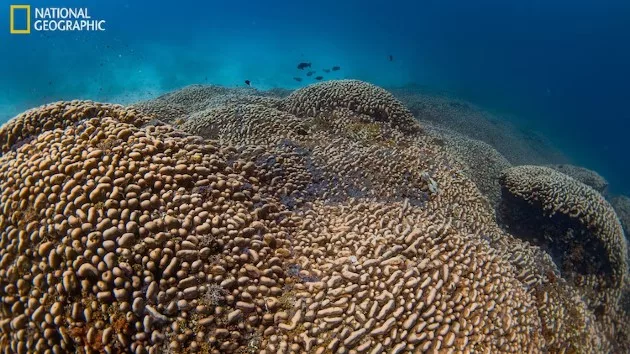
(LONDON) — On Thursday, as a National Geographic expedition was exploring the waters around the Solomon Islands, its members spotted something that looked like a shipwreck underwater. Intrigued, they sent a diver down to investigate.
The diver came back to the surface with extraordinary news.
The object was not a shipwreck but a massive coral — soon confirmed as the biggest coral in the world. The gigantic coral, which is visible from space and believed to be about 300 years old, stores an invaluable historical record of ocean conditions from past centuries.
“Just when we think there is nothing left to discover on planet earth, we find a massive coral made of nearly 1 billion little polyps, pulsing with life and color,” said Enric Sala, National Geographic Explorer in Residence and founder of Pristine Seas, the expedition that made the serendipitous discovery.
The coral is three times bigger than the previous record holder, which is known as “Big Momma” and located in American Samoa. While “Big Momma” is as tall as a giraffe, the new coral is the size of a blue whale.
The Solomon Islands, a cluster of hundreds of islands in the South Pacific and fittingly bordered by the Coral Sea, hosts the second highest coral diversity on the planet, boasting more than 490 known species.
“What many people don’t realize is that corals, though appearing as simple rocks, are actually living creatures that build these incredible habitats,” said Ronnie Posala, Fisheries officer at the Solomon Islands Ministry of Fisheries and Marine Resources.
He added that corals are critical defenses against the effects of climate change, saying that they “act as the first line of defense for coastal communities, buffering against powerful waves and storms.”
Corals and coral reefs are endangered due to global warming, which results in coral bleaching. According to UNESCO, the coral reefs in all 29 reef-containing World Heritage sites would cease to exist by the end of this century if human-created processes continue to emit the current level of greenhouse gasses.
“Despite its remote location, this coral is not safe from global warming and other human threats,” said Sala.
But the newly discovered reef also brings optimism, according to Eric Brown, a coral scientist on the National Geographic expedition.
“While the nearby shallow reefs were degraded due to warmer seas,” said Brown, “witnessing this large healthy coral oasis in slightly deeper waters is a beacon of hope.”
Copyright © 2024, ABC Audio. All rights reserved.








